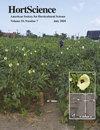Weather-based Scheduling and Pulse Drip Irrigation Increase Growth and Production of Northern Highbush Blueberry
IF 1.5
3区 农林科学
Q2 HORTICULTURE
引用次数: 0
Abstract
Northern highbush blueberry (Vaccinium corymbosum L.) often requires frequent irrigation for commercial production, but irrigation is becoming increasingly challenging for many growers because of warmer and drier weather conditions, increased water regulations, and other water-use limitations. The purpose of this study was to develop improved methods of irrigation to prepare the industry more effectively against future water uncertainties. Treatments were applied for 2 years (2021 and 2022) and included a combination of weather-based or fixed irrigation schedules using continuous or pulse irrigation in a commercial field of ‘Draper’ blueberry in eastern Washington, USA. The soil at the site was a silt loam, and irrigation was applied using two laterals of drip tubing per row. Plants on a fixed schedule were irrigated for 12 to 13 hours per application (set by the grower), whereas those on a weather-based schedule were irrigated according to daily estimates of crop evapotranspiration (downloaded from an automated weather station). In both cases, irrigation was applied every 2 to 4 days as a single, continuous application or in 30- to 50-minute pulses every 2 hours (up to nine times per day) with the same amount of water as the continuous treatment. During the first year of the study, weather-based scheduling maintained greater stem water potentials in the plants and, on average, increased yield by 3.4 t⋅ha–1, berry weight by 0.14 g/berry, berry diameter by 0.4 mm, and fruit bud set by 4.3% when compared with fixed scheduling. Likewise, pulse irrigation maintained greater stem water potentials and, on average, increased berry weight and diameter by 0.10 g and 0.4 mm, respectively, fruit bud set by 3.3%, and canopy cover by 2.4% relative to continuous irrigation. Yield and canopy cover were unaffected by any treatment in the second year, which was likely a result of uncharacteristically cool, wet weather in the spring. However, weather-based scheduling continued to maintain greater stem water potentials and, when combined with pulse irrigation, increased berry weight and diameter by 3.7 g and 1.0 mm, respectively, relative to continuous irrigation on a fixed schedule. Pulse drip irrigation also increased fruit bud set by 5.1% during the second year. These results demonstrate the potential benefits of using weather-based scheduling and pulse drip in northern highbush blueberry, especially when the plants are grown on light-textured soils in hot, dry climates.基于天气的调度和脉冲滴灌提高了北部高丛蓝莓的生长和产量
北部高丛蓝莓(Vaccinium corymbosum L.)在商业生产中通常需要频繁灌溉,但由于气候条件变暖和干旱、水法规的增加以及其他用水限制,灌溉对许多种植者来说正变得越来越具有挑战性。本研究的目的是开发改进的灌溉方法,使该行业更有效地应对未来水资源的不确定性。在美国华盛顿州东部的一块'Draper'蓝莓商品田中,采用了为期两年(2021 年和 2022 年)的处理方法,包括基于天气的灌溉计划或固定灌溉计划的组合,使用连续灌溉或脉冲灌溉。该地的土壤为淤泥质壤土,每行使用两路滴灌管进行灌溉。按照固定时间表灌溉的植物每次灌溉 12 到 13 个小时(由种植者设定),而按照气象时间表灌溉的植物则根据作物蒸散量的每日估计值(从自动气象站下载)进行灌溉。在这两种情况下,灌溉都是每 2 到 4 天进行一次连续灌溉,或每 2 小时进行一次 30 到 50 分钟的脉冲灌溉(每天最多 9 次),水量与连续灌溉相同。在研究的第一年,与固定调度相比,基于天气的调度能保持植株更高的茎部水势,平均产量增加了 3.4 吨-公顷-1,浆果重量增加了 0.14 克/颗,浆果直径增加了 0.4 毫米,果芽着生率增加了 4.3%。同样,与连续灌溉相比,脉冲灌溉保持了更高的茎干水势,平均而言,浆果重量和直径分别增加了 0.10 克和 0.4 毫米,果芽坐果率增加了 3.3%,冠层覆盖率增加了 2.4%。第二年的产量和冠层覆盖率没有受到任何处理的影响,这可能是春季异常凉爽潮湿的天气造成的。然而,与固定时间的连续灌溉相比,基于天气的调度继续保持较高的茎干水势,结合脉冲灌溉,浆果重量和直径分别增加了 3.7 克和 1.0 毫米。脉冲滴灌还能使第二年的果芽坐果率提高 5.1%。这些结果表明,在北方高丛蓝莓中使用基于天气的调度和脉冲滴灌具有潜在的益处,尤其是当植物生长在炎热干燥气候下的轻质土壤中时。
本文章由计算机程序翻译,如有差异,请以英文原文为准。
求助全文
约1分钟内获得全文
求助全文
来源期刊

Hortscience
农林科学-园艺
CiteScore
3.00
自引率
10.50%
发文量
224
审稿时长
3 months
期刊介绍:
HortScience publishes horticultural information of interest to a broad array of horticulturists. Its goals are to apprise horticultural scientists and others interested in horticulture of scientific and industry developments and of significant research, education, or extension findings or methods.
文献相关原料
| 公司名称 | 产品信息 | 采购帮参考价格 |
|---|
 求助内容:
求助内容: 应助结果提醒方式:
应助结果提醒方式:


